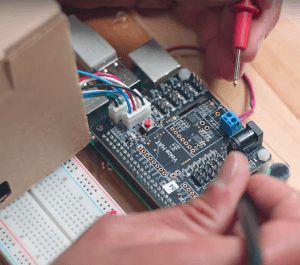Google AI Voice Kit: Big Brother in a cardboard box
June 20, 2018
on
on
If you’re a loyal Elektor reader, you’ll remember that at the end of the last century electronic voice communication was THE subject in these columns. We’re no longer talking of home automation, nor voice assistance, nor artificial intelligence. Today, voice recognition is back in force and in a very different environment. In June 2018 Amazon released the French version of its flagship product Alexa. French, although massacred by a growing number of French speakers, remains a difficult language to learn, just as much so for algorithms and artificial intelligence.
Google AI Voice Kit is designed for the Raspberry Pi plateform. In short, it is a HAT for the RPi. And it really does open up some new horizons. The kit comes with a full user manual. To get going, all you need is a RPi 3, with a good power supply (2 A) and an SD memory card.
To guide you once you have this extraordinary kit in your hands, the following two video tutorials are excellent resources, highly recommended:

A cardboard box to talk to Big Brother
The video chosen for you By Elektor TV this week describes the experimenter’s Google AI Voice Kit, with which Google attempts to put “his” intelligence to the service of voice communication between man and machine. One has to wonder about Google’s “generosity” in this, but it certainly is worthy of our attention. It doesn’t look up to much, as this kit is housed in a modest cardboard box. But don’t be fooled by appearances; its possibilities are vast, unlimited if you believe Google. In fact, the function of voice recognition is to eliminate all the usual interfaces: buttons, keyboards, joysticks. Man is communicating directly with artificial intelligence software. An unprecedented experience!Google AI Voice Kit is designed for the Raspberry Pi plateform. In short, it is a HAT for the RPi. And it really does open up some new horizons. The kit comes with a full user manual. To get going, all you need is a RPi 3, with a good power supply (2 A) and an SD memory card.
It’s not just a gadget!
It’s worth pointing out that in the box and on the HAT itself, there is not a lot happening. Together they form an interface , on one side to the loudspeaker and microphone, and on the other to the internet. There reside Google and its “& Sound” artificial intelligence. It’s thus in the cloud, that is to say on Google’s servers, that the important things happen. When your voice commands, processed by Google, come back in the form of a response to your cardboard box, they are converted into an audio signal and output to a loudspeaker.To guide you once you have this extraordinary kit in your hands, the following two video tutorials are excellent resources, highly recommended:
Read full article
Hide full article


Discussion (0 comments)